The Ghost Club was a regular haunt of Sir Arthur Conan Doyle, creator of Sherlock Holmes, along with Charles Dickens, Siegfried Sassoon, W B Yeats and Hammer horror film actor Peter Cushing.
This article contains affiliate links. We may earn a small commission on items purchased through this article, but that does not affect our editorial judgement.


From the two marriages the writer had five children. One of them, Kingsley, was badly wounded at the Battle of the Somme in 1916. Within two years he was dead from pneumonia. Conan Doyle’s brother, Brigadier-General Innes Doyle, died from the same disease in February 1919.
From around this time the author embraced spiritualism, seeking insight into the possibilities of life after death and other supernatural phenomena. In his enthusiasm he became susceptible to outlandish claims.
Advertisement
Hide AdAdvertisement
Hide AdIn 1922 he wrote “The Coming of the Fairies”, a book underpinning his belief that a series of photographs purporting to show living fairies were genuine. Young cousins Elsie and Francis Griffith featured in the photos that were taken in Elsie’s garden in Yorkshire in 1920 at Conan Doyle’s behest. A photographic expert had declared some earlier similar images to be authentic. Half a century elapsed before the photos were conclusively proved fake.


Over time Conan Doyle was taken in by a whole succession of people who assured him they had contact with the spirit world. Most were charlatans or, at best, deluded individuals. Conan Doyle even sincerely believed that ace escapologist Harry Houdini possessed supernatural powers - this despite Houdini’s own protestations that he was merely a very clever magician.
Next the writer joined the Ghost Club, a secretive body founded in 1862 that was dedicated to investigating hitherto unexplained phenomena. Women were barred from membership and the male members needed to demonstrate a belief in a spirit world, albeit a singularly elusive one!
Over the years other famous Ghost Club members included Charles Dickens and the Great War poet Siegfried Sassoon. Another poet member was W B Yeats. The Hammer horror film actor Peter Cushing also joined. Ironically Cushing played Sherlock Holmes on several occasions on the big screen and on TV. As a youth he also caught pneumonia twice but obviously survived. He had a Sussex connection in that he attended Shoreham Grammar School as a boarder but only spent a single term there. Indeed, one of his first professional acting roles was at the Connaught Theatre, Worthing.
Advertisement
Hide AdAdvertisement
Hide AdOne Ghost Club ritual required that the names of all members - both living and dead - were solemnly recited every November; each deceased was considered as remaining a member. The Ghost Club still exists to investigate and research the paranormal. Current Chairman Alan Murdie has written a book on “Haunted Brighton”.


I was intrigued to discover that Air Chief Marshal Hugh Dowding was once a member. Dowding is acknowledged as the mastermind who made the RAF victory in the 1940 Battle of Britain possible. Without Dowding’s pre-war lobbying, the Hurricane and Spitfire, the two aircraft that won the fight for the RAF, would have been built in far fewer numbers. Dowding pressed for fighter production to be given priority over bombers.
Dowding has an enduring link to our county through the Dowding Room in Sussexdown House in Storrington. He helped establish it as a home for injured RAF men and women in need of long-term care.
Hugh Dowding was nicknamed “Stuffy”, somewhat appropriate for a man who at face value was a pillar of society and not inclined to levity. Which makes it even more surprising that he should be drawn to the Ghost Club. However, he believed absolutely in reincarnation.
Advertisement
Hide AdAdvertisement
Hide AdAfter becoming a widower in 1920 he met his second wife after claiming he had communicated with her dead husband through a medium. In later life Dowding became convinced he had been a Mongol chieftain in a previous existence.
I have a fascinating footnote to this week’s column. My sister-in-law Gill Huxley has a family link to Sir Arthur Conan Doyle. Gill’s great grandmother, Mabel Annie St Clair Stobart, led an astonishing life that saw her lead a Flying Field Hospital over the mountains of southern Serbia in 1915 when aged well over 50. Of her experience she wrote: “The so-called glories of war which came under my notice … were butchered human beings, devastated villages and a general callousness about the value of human life.”
Have you read....: Unseen masterpiece by Constable unveiled for the first time in almost 200 years at Brighton’s Royal Pavilion
Advertisement
Hide AdAdvertisement
Hide AdShe added: “It is my belief that the co-operation of women in warfare is essential for the future abolition of war; essential that is for the retrieval of civilization.”
In 1919 her son Lionel and his wife Phyllis Mary died of the Spanish Flu in Canada. Then in 1928 both Mabel’s elder son Eric and her husband John passed on. As a result of these bereavements, she turned to Spiritualism, joining the British College of Psychic Science. She also struck up a close friendship with Conan Doyle who, of course, had also endured family tragedy and strongly believed in an afterlife.
Mabel died in 1954 aged 92.
For the latest breaking news where you live in Sussex, follow us on Twitter @Sussex_Worldand like us on Facebook @SussexWorldUK